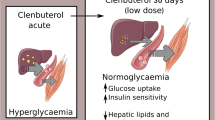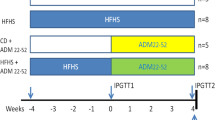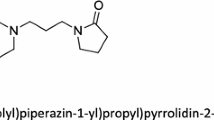Abstract
β3-adrenergic agonists have been considered as potent antiobesity and antidiabetic agents mainly on the basis of their beneficial actions discovered twenty years ago in obese and diabetic rodents. The aim of this work was to verify whether prolonged treatment with a β3-adrenergic agonist known to stimulate lipid mobilisation, could promote desensitization of β-adrenergic responses. Wistar rats and guinea pigs were treated during one week with CL 316243 (CL, 1 mg/kg/d) by implanted osmotic minipumps. In control animals, β3-adrenergic agonists were lipolytic in rat but not in guinea pig adipocytes. CL-treatment did not alter body weight gain in both species, but reduced fat stores in rats. Lipolysis stimulation by forskolin was unmodified but responses to β1-, β2- and β3-agonists were reduced in visceral or subcutaneous white adipose tissues of CL-treated rats. Similarly, the β3-adrenergic-dependent impairment of insulin action on glucose transport and lipogenesis in rat adipocytes was diminished after CL-treatment. In rat adipocytes, [125I]ICYP binding and β3-adrenoceptor mRNA levels were reduced after sustained CL administration. These findings show that CL 316243 exerts β3-adrenergic lipolytic and antilipogenic effects in rat adipocytes. These actions, which are likely involved in the fat depletion observed in rat, also lead to the desensitization of all β-adrenergic responses. Therefore this desensitization, together with the lack of slimming action in guinea pig, seriously attenuates the usefulness of β3-agonists as antiobesity agents, and may explain why such agonists have not been conducted to a widespread clinical, use.
Resumen
Los agonistas β3-adrenérgicos son considerados potentes agentes anti-obesidad y antidiabéticos debido, fundamentalmente, a los efectos beneficiosos que producen en roedores obesos y diabeticos, descubiertos ya hace veinte años. El objetivo del presente estudio fue verificar si un tratamiento prolongado con agonists β3-adrenérgicos, conocidos estimulantes de la movilización lipídica, puede promover la desensibilización de las respuestas β-adrenérgicas. Para ello, se trataron ratas Wistar y cobayas con CL 316243 (CL, 1 mg/kg/d), administrado mediante el implante de minibombas osmóticas, durante una semana. En los adipocitos de ratas control, pero no en los de cobayas control, los agonistas β3-adrenérgicos produjeron efectos lipolíticos. El tratamiento con CL no modificó la ganancia de peso en ninguna de las dos especies, pero redujo los depósitos de grasa en ratas. En el tejido adiposo visceral y subcutáneo de las ratas tratadas con CL, la estimulación de la lipólisis por forskolina no se vió afectada, pero las respuestas a agonistas β1, β2, y β3 se redujeron. De manera análoga, el deterioro de la función insulínica, en lo que al transporte de glucosa y la lipogénesis se refiere, producido por los adrenérgicos β3 y que sólo se observa en los adipocitos de rata, disminuyó tras el tratamiento con CL. En los adipocitos de rata, la unión a [125I]ICYP y los niveles de ARNm del receptor adrenérgico β3 disminuyeron con la administración sostenida de CL. Estos resultados demuestran que el CL 316243 produce efectos lipolítico y antilipogénico únicamente en los adipocitos de rata. Estas acciones, muy probablemente relacionadas con la depleción de grasa observada en la rata, conducen a la desensibilización de todas las respuestas β-adrenérgicas. Esta desensibilización, junto con la ausencia de efecto adelgazante en cobayas, reduce la utilidad de los agonistas β3-adrenérgicos como agentes antiobesidad y podría explicar por qué no se han utilizado en la práctica clínica habitual como nuevos fármacos.
Similar content being viewed by others
References
Abe, H., Minokoshi, Y., and Shimazu, T. (1993): J. Endocrinol., 139, 479–486.
Arch, J. R., Ainsworth, A. T., Cawthorne, M. A., Percy, V., Sennit, M. V., Thody, E., Wilson, C., and Wilson, S. (1984): Nature, 309, 163–165.
Atgié, C., D’Allaire, F., and Bukowiecki, L. J. (1997): Am. J. Physiol. Cell Physiol., 42, C1136-C1142.
Atgié, C., Faintrenie, G., Carpéné, C., Bukowiecki, L. J., and Géloën, A. (1998): Comp. Biochem. Physiol. 119A, 629–636.
Atgié, C., Tavernier, G., D’Allaire, F., Bengtsson, T., Marti, L., Carpéné, C., Lafontan, M., Bukowiecki, L. J. and Lagin, D. (1996): Am. J. Physiol., 271, R1729-R1738.
Bairras, C., Ferrand, C., and Atgié, C. (2003): J. Physiol. Biochem., 59, 161–168.
Bloom, J. D., Dutia, M. D., Johnson, B. D., Wissner, A., Burns, M. G., Largis, E. E., Dolan, J. A., and Claus, T. H. (1992): J. Med. Chem., 35, 3081–3084.
Bour, S., Visentin, V., Prévot, D., and Carpéné, C. (2003). J. Physiol. Biochem., 59, 169–175.
Carpéne, C., Ambid, L., and Lafontan, M. (1994): Am. J. Physiol., 266, R896-R904.
Carpené, C., Chalaux, E., Lizarbe, M., Estrada, A., Mora, C., Palacin, M., Zorzano, A., Lafontan, M., and Testar, X. (1993). Biochem. J., 296, 99–105.
Chaudry, A., MacKenzie, R. G., Georgic, L. M., and Granneman, J. G. (1994): Cell Signalling, 6, 457–465.
Duffaut, C., Bour, S., Prévot, D., Marti, L., Testar, X., Zorzano, A. and Carpéné, C. (2006): J. Physiol. Biochem., 62, 101–112.
Granneman, J. G. (1995): Cell. Signal., 7, 9–15.
Granneman, J. G., Li, P., Zhu, Z., and Lu, Y. (2005): Am. J. Physiol. Endocrinol. Metab., 289, E608-E616.
Green, A. R., Carroll, R. M., and Dobias, S. B. (1996): Am. J. Physiol., 271, E271-E276.
Hausdorff, W. P., Caron, M. G., and Lefkowitz. (1990): Fed. Am. Soc. Exp. Biol., 4, 2881–2891.
Himms-Hagens, J. J., Cui., J., Danforth, E., Taajes, D., Langs, S., Waters, B., and Claus, T. (1994): Am. J. Physiol., 266, R1371-R1382.
Howe, R. (1993): Drugs of the future, 18, 529–549.
Issad, T., Combettes, M., Ferré, P. (1995): Eur. J. Biochem. 234: 108–115.
Jost, M. M., Jost, P., Klein, J., and Klein, H. H. (2005): Exp. Clin. Endocrinol. Diabetes, 113, 418–422.
Lafontan, M. and Berlan, M. (1993): J. Lipid Res., 34, 1057–1091.
Lamas, O., Martínez, J.A., and Marti, A. (2003): J. Physiol. Biochem., 59, 183–192.
Ligget, S. B., Freedman, N. J., Schwinn, D. A. and Lefkowitz, R. J. (1993): Proc. Natl. Acad. Sci., 90, 3665–3669.
Lipworth, B.J. (1996): Br. J. Clin. Pharmacol., 42:291–300.
Liu, Y. L., Cawthorne, M. A., and Stock, M. J. (1996): Br. J. Pharmacol., 117, 1355–1361.
Lönnqvist, F., Krief, S., Strosberg, A. D., Nyberg, B., Emorine, L. J., and Arner, P. (1993): Br. J. Pharmacol., 110, 929–936.
Milagro, F. I., Gómez-Ambrosi, J., Martínez-Anso, E., and Martínez, J. A. (1999): J. Physiol. Biochem., 55, 25–31.
Moody, A. J., Stan, A. M., and Gliemann, J. (1974): Horm. Metab. Res., 6, 12–16.
Nantel, F., Bonin, H., Emorine, L. J., Zilberfarb, V., Strosberg, A. D., Bouvier, M., Marullo, S. (1993): Mol. Pharmacol., 43, 548–555.
Nantel, F., Bonnin, H., Emorine, L. J., Zilberfarb, V., Strosberg, A. D., Bouvier, M. and Marullo, S. (1993): Mol. Pharmacol., 43, 548–555.
Pott, C., Brixius, K., Bloch, W., Ziskoven, C., Napp, A., and Schwinger, R. H. (2006): Pharmazie, 61, 255–260.
Sawa, M., and Harada, H. Curr. Med. Chem. (2006): 13, 25–37.
Strosberg, A. D., and Pietri-Rouxel. (1996): Trends Pharmacol. Sci., 17, 373–381.
Susulic, VS, Frederic, RC, Lawitts, J., Tozzo, E., Kahn, B. B., Harper, M. E., Himms-Hagen, J., Flier, J. S., and Lowell, B. B. (1995): J. Biol. Chem., 270, 29483–29492.
White, C. L., Ishihara, Y., Doston, T. L., Hughes, D. A., Bray, G. A., and York, D. A. (2004): Physiol. Behav., 82, 489–496.
Yoshida, T., Sakane, N., Wakabayashi, T., Umekawa, T., and Kondo, M. (1994): Lif Sci., 54, 491–498.
Author information
Authors and Affiliations
Corresponding author
Rights and permissions
About this article
Cite this article
Ferrand, C., Redonnet, A., Prévot, D. et al. Prolonged treatment with the β3-adrenergic agonist CL 316243 induces adipose tissue remodeling in rat but not in guinea pig: 1) fat store depletion and desensitization of β-adrenergic responses. J. Physiol. Biochem. 62, 89–99 (2006). https://doi.org/10.1007/BF03174070
Received:
Issue Date:
DOI: https://doi.org/10.1007/BF03174070




